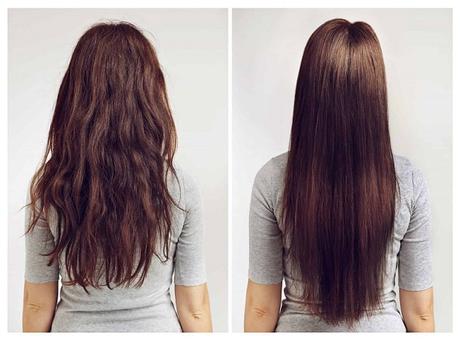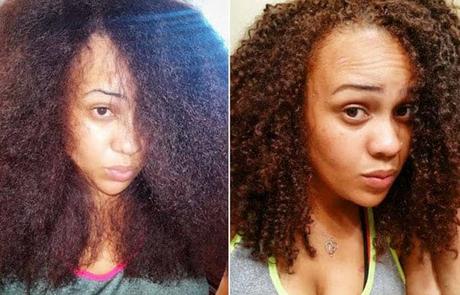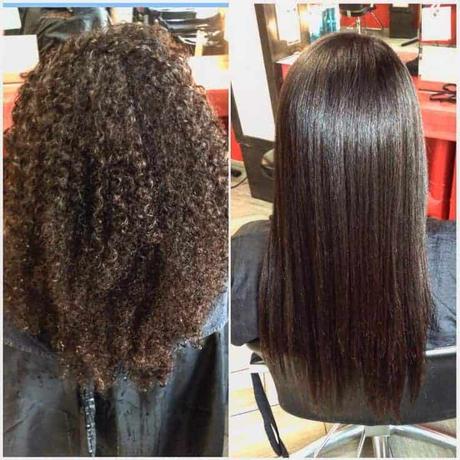Introduction
First, don’t be fooled by the phrase “reconditioning.” This is a chemical straightening process that is fairly new on the market. It is designed for curly to wavy hair types only, and it also contains the chemical ammonium thioglycolate in a low-percentage solution. This process involves using an electric flat iron and is safe for permanently coloured hair or hair that has been previously straightened with another ammonium thioglycolate product. Like any new process, it has spectacular pros and some dismal cons. In other words, there’s good news and there’s bad news.
 Thermal Reconditioning: Before and After
Thermal Reconditioning: Before and After
The good news is that thermal reconditioning can transform curly or wavy hair into silky, straight hair with a minimum of damage. The bad news is that, as with any innovative technique, many stylists jump on the bandwagon and proclaim themselves thermal-reconditioning specialists. That seems to justify their charging $500 to $1,000 for initial treatment. Furthermore, the curlier your hair is, the more often touch-ups are required and, unlike a perm touch-up, you’ll wind up paying just as much to recondition any new growth as you did to do your entire head. Here’s the arithmetic: Every two to three months you can expect to pay $1,000 to $2,000 for reconditioning treatments alone. If you add to that whatever you typically pay for colouring, cutting, and regular salon visits, that’s a hefty price to pay even if you are a diehard straight-styled gal. And did I mention that committing to thermal reconditioning means that you’ll have stick-straight hair without an ounce of the body?
No matter what process you choose, it is in your best interest to be familiar with each of these treatments so that you choose what best suits your hair type and desired style. In choosing any one of these chemical services, it is of the utmost importance to thoroughly understand the commitment involved for your hair and scalp upkeep and maintenance, so by all means, educate yourself and do your research. By the time you consult with your stylist, you’ll be able to ask some intelligent questions. I realize that this advice may seem weird to many of you who have been straightening your hair for years. Again, I want to remind you that hair science changes and there are improved (and safer) products and techniques to use. What you’re used to could very well be obsolete, and your stylist (if she or he keeps up with current trends) may be able to use something better on your hair. Don’t you think it’s worth finding out?
……What Say?
Speaking of stylists, if you know you’re going to be switching hairstylists, make sure you have your former stylist provide you with a record of what method and product were used on your hair. (I know this might be tricky if you’re changing stylists because of dissatisfaction, but figure out some way to leave with this information.) The next stylist who does your hair will then have an accurate history of what’s been done. He can’t necessarily tell just by looking at what’s sitting in front of him what kind of relaxer was used on your hair. And while there are some daring artists out there who are willing to try anything with hair, it’s just not advisable when it comes to hair that’s been chemically straightened or texturized. The hydroxide relaxers and thioglycolate are not interchangeable. You should never apply either hydroxide to your hair if it’s been previously altered with thioglycolate or vice versa. Mix those and what you’ll get is extreme breakage, and what’s left of your hair will turn to mush. Believe me, you don’t ever want to have that happen to you or even see it.
Understanding your hair type and how you want your hair to look is sound preparation for committing relaxing or texturizing your hair. Remember to be flexible when talking to your stylist with all the information you have. What you see, and what you imagine, may not ultimately be what you should have.
Once you have decided that it is time for a chemical process, you will fall into one of two categories:
A woman with natural hair who is seeking more versatility in hair texture, but who fundamentally likes the look and feel of curly or wavy hair and doesn’t wish to straighten it, or
A woman who already relaxes her hair, and is ready for a touch-up.
If you’re in the first category of women, texturizing is probably what you’d like, because when done well, it’s a subtle enhancement of your hair’s natural curl or coil. For those who want to continue with straightened hair, there are some important things to consider about just how to alter your new growth while maintaining your already straightened hair. So, let’s take a look.
Texturizing
In texturizing natural hair, a very mild relaxer is used and applied in a careful manner so as not to disturb the hair’s natural spring or curl. Depending on the texture you’ve got and the one you’re trying to achieve, it’s best if your stylist performs this treatment. Texturizing hair is a delicate procedure. (It’s all in the timing.) If you try to do it at home, you run the risk of overstraightening your hair. Slathering and caking the texturizer into hair, or applying it with a largetoothed comb, then leaving it on for too long, have been done by many a do-ityourselfer. With a pro, when done correctly, texturizing will enhance your hair beautifully by lengthening it and giving your hair a looser curl.

Texturizing can be done with either a mild sodium hydroxide or calcium hydroxide relaxer or an ammonium thioglycolate relaxer. Which to use depends solely on your hair texture. Kinky-spongy or curly-spongy hair, i.e., hair that doesn’t have a smooth cuticle, is best texturized using sodium hydroxide or calcium hydroxide. For those of you who have hair that is curly or wavy, ammonium thioglycolate is the most appropriate relaxer to use. Be sure your stylist is aware of the differences for each hair texture because otherwise the results could be devastating.
Your texturized hair should not appear as if it was chemically altered. Instead you should have a natural curl-enhanced effect. Unlike straightened hair, texturized hair needs to be touched up only every three to five months. Infrequent touch-ups are one of many advantages of having texturized hair. Another is the fact that the scalp is less involved, less subject to burning and chemical absorption of potential carcinogens. Many of the problems associated with chemical straightening and damage to one’s scalp are minimized when hair is texturized.
Maintenance is a breeze. In fact, texturized hair can be cared for the same as your natural hair. The hair can be rewet, reconditioned, and, with a little styling lotion, conditioning gel, foam, or a nice fragrant essential oil, styled as often as desired. Your texturized hair should be air-dried or dried under a portable hood dryer. What could be simpler than that?
Chemical Straightening

If you’re chemically straightening your hair, take heed of the upkeep and commitment involved with such an extreme permanent process. You’re taking your hair to its absolute max and because of that, you need to be disciplined with your maintenance routine. Skin and other body tissues absorb chemicals, allowing them to get into your bloodstream and increasing the risk of exposure to carcinogens. It’s highly recommended that shampooing not be done for one full week prior to getting your hair chemically straightened. This is recommended so that the scalp can accumulate as much oil as possible to protect itself from the toxic effect of sodium hydroxide or the thioglycolate. (This is an additional precaution used along with basing the scalp with a petroleum protectant.) The body and scalp are susceptible to dermatitis, so make sure your scalp is liberally based before applying any chemical relaxers.
Handle with Loving Care
Touch-ups, the relaxing of new growth, must be done with meticulous care. I do not recommend that touch-ups be done at home. Professionals are best for this delicate procedure. Touch-ups can cause severe damage and breakage to previously relaxed hair, particularly around the hairline and the nape of the neck. Take note and be concerned about any stylist who is cheerfully applying chemical relaxer beyond your new growth. (As a matter of fact, the first time you go to a stylist, go early. See how she or he works with hair similar to yours. If she gets slap-happy with the relaxer and spends more time chatting up the client than paying attention to how much and where she is placing relaxer, I suggest you start talking into your cell phone as if your kids just called to tell you they’ve set the house on fire, and then get the hell out of that salon!)
Hair relaxed straight should be shampooed once a week, deep conditioned, and wet set. If you’re an active woman who works out, be sure to wear a terrycloth sweatband along your hairline while you’re at the gym or health club. Afterward, a light blow-dry on cool with your comb attachment is permissible. For the regular styling of relaxed hair, I recommend wet setting, or wrapping the hair with a light setting lotion and blow-drying it on low to medium heat only. If you have a short Halle Berry cut, it can be a breeze. Just wrap and go.
Remember earlier I said that relaxing is an extreme process? What that means in real terms is that your hair is now more fragile and drier than it was. That’s true whether you have thick hair or thin hair, coarse or fine. The point is, if you have hair, it’s now in a more vulnerable state. Handle with care. Before you use a hot comb or a curling iron to style your hair, consider that you’re literally playing with fire! Ultimately what you’ll end up with is extremely damaged, broken hair. Think about it: If you’re going to use all that heat on your hair, why would you relax it straight in the first place? Keep the high heat for unstraightened hair. (It can take the stress better.) Instead, learn how to wet set your hair to achieve a beautiful style.
That’s one of the reasons I’ve written an entire chapter on the virtues of wet setting. Thanks to wet setting you can have beautifully relaxed hair and style it however you like, all the while minimizing the risk of long-term damage. If that’s not win-win, I don’t know what is!
Final Words
I recommend that you treat your scalp after every touch-up or chemical service with essential oils such as comfrey, peppermint, tea tree, or horsetail. Their soothing, astringent properties are a great boost to your hair and scalp’s general well-being. Using light essential oils after a chemical process serves to remind you that they have been subjected to a demanding treatment, and helps to balance out some of the stress. You can find most of these oils in health food stores.
For all chemically straightened or texturized hair, I can’t stress enough that it’s best to sleep with a satin scarf or pillowcase. Cotton absorbs oil and frizzes the hair. Allowing your hair to get frizzy defeats the purpose of all the massaging and conditioning you’re committed to doing, right?
All that I’ve shared with you in this chapter is to help you be a more mindful consumer and caretaker of your hair. With this information, and armed with some great tips in terms of your choices, your chemical experience can be a spectacular success.
If you are experiencing hair loss, it is always best to consult your physician about how to manage your nutrient deficiency. I have reviewed different types of hair loss shampoos for healthy hair growth also you can have a look at Folexin, Folexin is 100% natural and organic supplement to prevent hair loss and support healthy hair growth.
